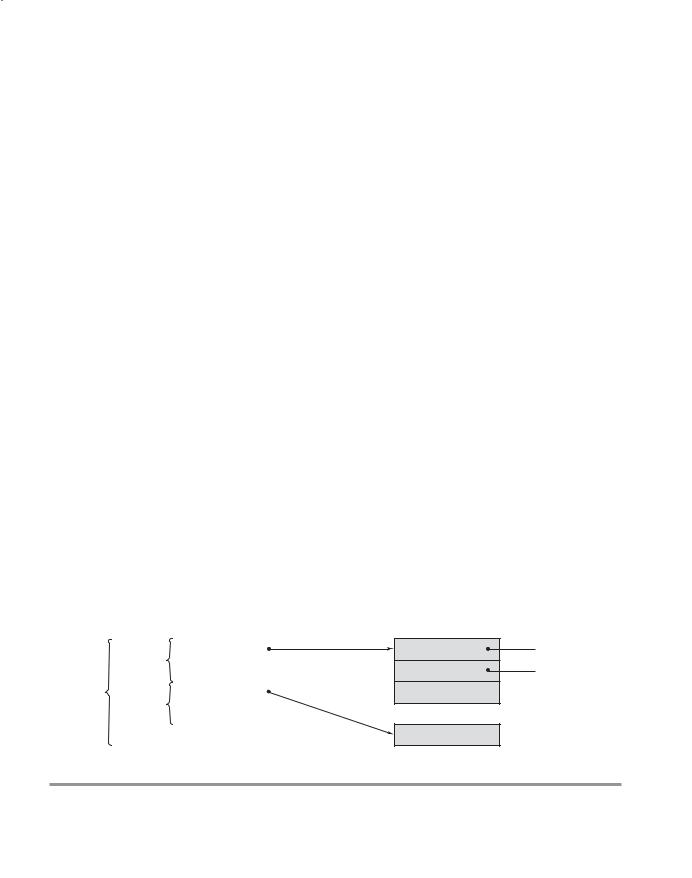
- •New to the Tenth Edition
- •Preface
- •Acknowledgments
- •About the Author
- •Contents
- •1.1 Reasons for Studying Concepts of Programming Languages
- •1.2 Programming Domains
- •1.3 Language Evaluation Criteria
- •1.4 Influences on Language Design
- •1.5 Language Categories
- •1.6 Language Design Trade-Offs
- •1.7 Implementation Methods
- •1.8 Programming Environments
- •Summary
- •Problem Set
- •2.1 Zuse’s Plankalkül
- •2.2 Pseudocodes
- •2.3 The IBM 704 and Fortran
- •2.4 Functional Programming: LISP
- •2.5 The First Step Toward Sophistication: ALGOL 60
- •2.6 Computerizing Business Records: COBOL
- •2.7 The Beginnings of Timesharing: BASIC
- •2.8 Everything for Everybody: PL/I
- •2.9 Two Early Dynamic Languages: APL and SNOBOL
- •2.10 The Beginnings of Data Abstraction: SIMULA 67
- •2.11 Orthogonal Design: ALGOL 68
- •2.12 Some Early Descendants of the ALGOLs
- •2.13 Programming Based on Logic: Prolog
- •2.14 History’s Largest Design Effort: Ada
- •2.15 Object-Oriented Programming: Smalltalk
- •2.16 Combining Imperative and Object-Oriented Features: C++
- •2.17 An Imperative-Based Object-Oriented Language: Java
- •2.18 Scripting Languages
- •2.19 The Flagship .NET Language: C#
- •2.20 Markup/Programming Hybrid Languages
- •Review Questions
- •Problem Set
- •Programming Exercises
- •3.1 Introduction
- •3.2 The General Problem of Describing Syntax
- •3.3 Formal Methods of Describing Syntax
- •3.4 Attribute Grammars
- •3.5 Describing the Meanings of Programs: Dynamic Semantics
- •Bibliographic Notes
- •Problem Set
- •4.1 Introduction
- •4.2 Lexical Analysis
- •4.3 The Parsing Problem
- •4.4 Recursive-Descent Parsing
- •4.5 Bottom-Up Parsing
- •Summary
- •Review Questions
- •Programming Exercises
- •5.1 Introduction
- •5.2 Names
- •5.3 Variables
- •5.4 The Concept of Binding
- •5.5 Scope
- •5.6 Scope and Lifetime
- •5.7 Referencing Environments
- •5.8 Named Constants
- •Review Questions
- •6.1 Introduction
- •6.2 Primitive Data Types
- •6.3 Character String Types
- •6.4 User-Defined Ordinal Types
- •6.5 Array Types
- •6.6 Associative Arrays
- •6.7 Record Types
- •6.8 Tuple Types
- •6.9 List Types
- •6.10 Union Types
- •6.11 Pointer and Reference Types
- •6.12 Type Checking
- •6.13 Strong Typing
- •6.14 Type Equivalence
- •6.15 Theory and Data Types
- •Bibliographic Notes
- •Programming Exercises
- •7.1 Introduction
- •7.2 Arithmetic Expressions
- •7.3 Overloaded Operators
- •7.4 Type Conversions
- •7.5 Relational and Boolean Expressions
- •7.6 Short-Circuit Evaluation
- •7.7 Assignment Statements
- •7.8 Mixed-Mode Assignment
- •Summary
- •Problem Set
- •Programming Exercises
- •8.1 Introduction
- •8.2 Selection Statements
- •8.3 Iterative Statements
- •8.4 Unconditional Branching
- •8.5 Guarded Commands
- •8.6 Conclusions
- •Programming Exercises
- •9.1 Introduction
- •9.2 Fundamentals of Subprograms
- •9.3 Design Issues for Subprograms
- •9.4 Local Referencing Environments
- •9.5 Parameter-Passing Methods
- •9.6 Parameters That Are Subprograms
- •9.7 Calling Subprograms Indirectly
- •9.8 Overloaded Subprograms
- •9.9 Generic Subprograms
- •9.10 Design Issues for Functions
- •9.11 User-Defined Overloaded Operators
- •9.12 Closures
- •9.13 Coroutines
- •Summary
- •Programming Exercises
- •10.1 The General Semantics of Calls and Returns
- •10.2 Implementing “Simple” Subprograms
- •10.3 Implementing Subprograms with Stack-Dynamic Local Variables
- •10.4 Nested Subprograms
- •10.5 Blocks
- •10.6 Implementing Dynamic Scoping
- •Problem Set
- •Programming Exercises
- •11.1 The Concept of Abstraction
- •11.2 Introduction to Data Abstraction
- •11.3 Design Issues for Abstract Data Types
- •11.4 Language Examples
- •11.5 Parameterized Abstract Data Types
- •11.6 Encapsulation Constructs
- •11.7 Naming Encapsulations
- •Summary
- •Review Questions
- •Programming Exercises
- •12.1 Introduction
- •12.2 Object-Oriented Programming
- •12.3 Design Issues for Object-Oriented Languages
- •12.4 Support for Object-Oriented Programming in Smalltalk
- •12.5 Support for Object-Oriented Programming in C++
- •12.6 Support for Object-Oriented Programming in Objective-C
- •12.7 Support for Object-Oriented Programming in Java
- •12.8 Support for Object-Oriented Programming in C#
- •12.9 Support for Object-Oriented Programming in Ada 95
- •12.10 Support for Object-Oriented Programming in Ruby
- •12.11 Implementation of Object-Oriented Constructs
- •Summary
- •Programming Exercises
- •13.1 Introduction
- •13.2 Introduction to Subprogram-Level Concurrency
- •13.3 Semaphores
- •13.4 Monitors
- •13.5 Message Passing
- •13.6 Ada Support for Concurrency
- •13.7 Java Threads
- •13.8 C# Threads
- •13.9 Concurrency in Functional Languages
- •13.10 Statement-Level Concurrency
- •Summary
- •Review Questions
- •Problem Set
- •14.1 Introduction to Exception Handling
- •14.2 Exception Handling in Ada
- •14.3 Exception Handling in C++
- •14.4 Exception Handling in Java
- •14.5 Introduction to Event Handling
- •14.6 Event Handling with Java
- •14.7 Event Handling in C#
- •Review Questions
- •Problem Set
- •15.1 Introduction
- •15.2 Mathematical Functions
- •15.3 Fundamentals of Functional Programming Languages
- •15.4 The First Functional Programming Language: LISP
- •15.5 An Introduction to Scheme
- •15.6 Common LISP
- •15.8 Haskell
- •15.10 Support for Functional Programming in Primarily Imperative Languages
- •15.11 A Comparison of Functional and Imperative Languages
- •Review Questions
- •Problem Set
- •16.1 Introduction
- •16.2 A Brief Introduction to Predicate Calculus
- •16.3 Predicate Calculus and Proving Theorems
- •16.4 An Overview of Logic Programming
- •16.5 The Origins of Prolog
- •16.6 The Basic Elements of Prolog
- •16.7 Deficiencies of Prolog
- •16.8 Applications of Logic Programming
- •Review Questions
- •Programming Exercises
- •Bibliography
- •Index

12.10 Support for Object-Oriented Programming in Ruby |
563 |
the parent class seems to be a cleaner solution than the friend functions and classes of C++.
The inclusion in C++ of constructors and destructors for initialization of objects is good, but Ada 95 includes no such capabilities.
Another difference between these two languages is that the designer of a C++ root class must decide whether a particular member function will be statically or dynamically bound. If the choice is made in favor of static binding, but a later change in the system requires dynamic binding, the root class must be changed. In Ada 95, this design decision need not be made with the design of the root class. Each call can itself specify whether it will be statically or dynamically bound, regardless of the design of the root class.
12.10 Support for Object-Oriented Programming in Ruby
As stated previously, Ruby is a pure object-oriented programming language in the sense of Smalltalk. Virtually everything in the language is an object and all computation is accomplished through message passing. Although programs have expressions that use infix operators and therefore have the same appearance as expressions in languages like Java, those expressions actually are evaluated through message passing. As is the case with Smalltalk, when one writes a + b, it is executed as sending the message + to the object referenced by a, passing a reference to the object b as a parameter. In other words, a + b is implemented as a.+ b.
12.10.1General Characteristics
Ruby class definitions differ from those of languages such as C++ and Java in that they are executable. Because of this, they are allowed to remain open during execution. A program can add members to a class any number of times, simply by providing secondary definitions of the class that include the new members. During execution, the current definition of a class is the union of all definitions of the class that have been executed. Method definitions are also executable, which allows a program to choose between two versions of a method definition during execution, simply by putting the two definitions in the then and else clause of a selection construct.
All variables in Ruby are references to objects, and all are typeless. Recall that the names of all instance variables in Ruby begin with an at sign (@).
In a clear departure from the other common programming languages, access control in Ruby is different for data than it is for methods. All instance data has private access by default, and that cannot be changed. If external access to an instance variable is required, accessor methods must be defined. For example, consider the following skeletal class definition:
class MyClass
# A constructor

564 |
Chapter 12 Support for Object-Oriented Programming |
def initialize @one = 1 @two = 2
end
#A getter for @one def one
@one end
#A setter for @one
def one=(my_one) @one = my_one
end
end # of class MyClass
The equal sign ( =) attached to the name of the setter method means that its variable is assignable. So, all setter methods have equal signs attached to their names. The body of the one getter method illustrates the Ruby design of methods returning the value of the last expression evaluated when there is no return statement. In this case, the value of @one is returned.
Because getter and setter methods are so frequently needed, Ruby provides shortcuts for both. If one wants a class to have getter methods for the two instance variables, @one and @two, those getters can be specified with the single statement in the class:
attr_reader :one, :two
attr_reader is actually a function call, using :one and :two as the actual parameters. Preceding a variable with a colon (:) causes the variable name to be used, rather than dereferencing it to the object to which it refers.
The function that similarly creates setters is called attr_writer. This function has the same parameter profile as attr_reader.
The functions for creating getter and setter methods are so named because they provide the protocol for objects of the class, which then are called attributes. So, the attributes of a class define the data interface (the data made public through accessor methods) to objects of the class.
Ruby objects are created with new, which implicitly calls a constructor. The usual constructor in a Ruby class is named initialize. A constructor in a subclass can initialize the data members of the parent class that have setters defined. This is done by calling super with the initial values as actual parameters. super calls the method in the parent class that has the same name as the method in which the call to super appears.

12.10 Support for Object-Oriented Programming in Ruby |
565 |
Class variables, which are specified by preceding their names with two at signs (@@), are private to the class and its instances. That privacy cannot be changed. Also, unlike global and instance variables, class variables must be initialized before they are used.
12.10.2Inheritance
Subclasses are defined in Ruby using the less-than symbol (<), rather than the colon of C++. For example,
class MySubClass < BaseClass
One distinct thing about the method access controls of Ruby is that they can be changed in a subclass, simply by calling the access control functions. This means that two subclasses of a base class can be defined so that objects of one of the subclasses can access a method defined in the base class, but objects of the other subclass cannot. Also, this allows one to change the access of a publicly accessible method in the base class to a privately accessible method in the subclass. Such a subclass obviously cannot be a subtype.
Ruby modules provide a naming encapsulation that is often used to define libraries of functions. Perhaps the most interesting aspect of modules, however, is that their functions can be accessed directly from classes. Access to the module in a class is specified with an include statement, such as
include Math
The effect of including a module is that the class gains a pointer to the module and effectively inherits the functions defined in the module. In fact, when a module is included in a class, the module becomes a proxy superclass of the class. Such a module is a mixin.
12.10.3Dynamic Binding
Support for dynamic binding in Ruby is the same as it is in Smalltalk. Variables are not typed; rather, they are all references to objects of any class. So, all variables are polymorphic and all bindings of method calls to methods are dynamic.
12.10.4Evaluation
Because Ruby is an object-oriented programming language in the purest sense, its support for object-oriented programming is obviously adequate. However, access control to class members is weaker than that of C++. Ruby does not support abstract classes or interfaces, although mixins are closely related to interfaces. Finally, in large part because Ruby is interpreted, its execution efficiency is far worse than that of the compiled languages.

566 |
Chapter 12 Support for Object-Oriented Programming |
12.11 Implementation of Object-Oriented Constructs
There are at least two parts of language support for object-oriented programming that pose interesting questions for language implementers: storage structures for instance variables and the dynamic bindings of messages to methods. In this section, we take a brief look at these.
12.11.1Instance Data Storage
In C++, classes are defined as extensions of C’s record structures—structs. This similarity suggests a storage structure for the instance variables of class instances—that of a record. This form of this structure is called a class instance record (CIR). The structure of a CIR is static, so it is built at compile time and used as a template for the creation of the data of class instances. Every class has its own CIR. When a derivation takes place, the CIR for the subclass is a copy of that of the parent class, with entries for the new instance variables added at the end.
Because the structure of the CIR is static, access to all instance variables can be done as it is in records, using constant offsets from the beginning of the CIR instance. This makes these accesses as efficient as those for the fields of records.
12.11.2Dynamic Binding of Method Calls to Methods
Methods in a class that are statically bound need not be involved in the CIR for the class. However, methods that will be dynamically bound must have entries in this structure. Such entries could simply have a pointer to the code of the method, which must be set at object creation time. Calls to a method could then be connected to the corresponding code through this pointer in the CIR. The drawback to this technique is that every instance would need to store pointers to all dynamically bound methods that could be called from the instance.
Notice that the list of dynamically bound methods that can be called from an instance of a class is the same for all instances of that class. Therefore, the list of such methods must be stored only once. So the CIR for an instance needs only a single pointer to that list to enable it to find called methods. The storage structure for the list is often called a virtual method table (vtable). Method calls can be represented as offsets from the beginning of the vtable. Polymorphic variables of an ancestor class always reference the CIR of the correct type object, so getting to the correct version of a dynamically bound method is assured. Consider the following Java example, in which all methods are dynamically bound:
public class A {
public int a, b;
public void draw() { ... }
public int area() { ... }
}

Class instance Record for A
Class instance Record for B
Figure 12.7
12.11 Implementation of Object-Oriented Constructs |
567 |
public class B extends A { public int c, d;
public void draw() { ... } public void sift() { ... }
}
The CIRs for the A and B classes, along with their vtables, are shown in Figure 12.7. Notice that the method pointer for the area method in B’s vtable points to the code for A’s area method. The reason is that B does not override A’s area method, so if a client of B calls area, it is the area method inherited from A. On the other hand, the pointers for draw and sift in B’s vtable point to B’s draw and sift. The draw method is overridden in B and sift is defined as an addition in B.
Multiple inheritance complicates the implementation of dynamic binding. Consider the following three C++ class definitions:
class A {
public:
int a; |
|
||
virtual void fun() { ... } |
|
||
virtual void init() { ... } |
|
||
}; |
|
|
|
class B { |
|
||
|
|
vtable for A |
|
|
|
|
code for A’s draw |
vtable pointer |
|
|
|
|
|
|
|
a |
|
|
code for A’s area |
|
|
|
|
b |
|
|
|
|
|
|
|
|
|
vtable for B |
|
|
|
|
code for A’s area |
vtable pointer |
|
|
|
|
|
|
code for B’s draw |
a |
|
|
|
|
|
|
|
b |
|
|
code for B’s sift |
|
|
|
|
c |
|
|
|
|
|
|
|
d |
|
|
|
|
|
|
|
An example of the CIRs with single inheritance

568 Chapter 12 Support for Object-Oriented Programming
public: int b;
virtual void sum() { ... }
};
class C : public A, public B { public:
int c;
virtual void fun() { ... } virtual void dud() { ... }
};
The C class inherits the variable a and the init method from the A class. It redefines the fun method, although both its fun and that of the parent class A are potentially visible through a polymorphic variable (of type A). From B, C inherits the variable b and the sum method. C defines its own variable, c, and defines an uninherited method, dud. A CIR for C must include A’s data, B’s data, and C’s data, as well as some means of accessing all visible methods. Under single inheritance, the CIR would include a pointer to a vtable that has the addresses of the code of all visible methods. With multiple inheritance, however, it is not that simple. There must be at least two different views available in the CIR—one for each of the parent classes, one of which includes the view for the subclass, C. This inclusion of the view of the subclass in the parent class’s view is just as in the implementation of single inheritance.
There must also be two vtables: one for the A and C view and one for the B view. The first part of the CIR for C in this case can be the C and A view, which begins with a vtable pointer for the methods of C and those inherited from A, and includes the data inherited from A. Following this in C’s CIR is the B view part, which begins with a vtable pointer for the virtual methods of B, which is followed by the data inherited from B and the data defined in C. The CIR for C is shown in Figure 12.8.
|
|
vtable pointer |
|
C and A’s part |
|
|
a |
|
|
|
|
Class instance |
|
|
|
vtable pointer |
|
Record for C |
|
|
B’s part |
|
|
|
b |
|
|
|
|
|
|
|
|
C’s data |
c |
|
|
C’s vtable for (C and A part)
 code for A’s init
code for A’s init
 code for C’s fun
code for C’s fun

 code for C’s dud
code for C’s dud
C’s vtable (B part)

 code for B’s sum
code for B’s sum
Figure 12.8
An example of a subclass CIR with multiple parents
